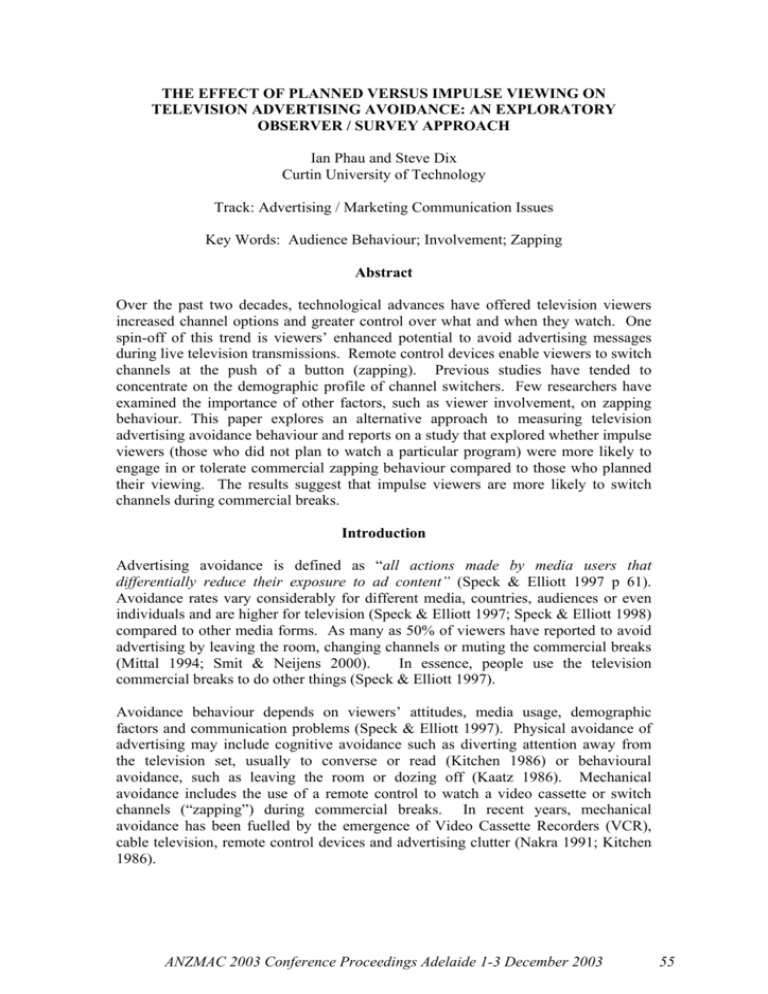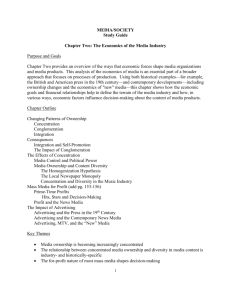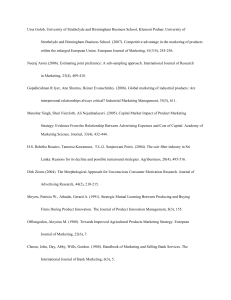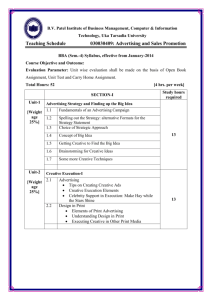THE EFFECT OF PLANNED VERSUS IMPULSE VIEWING
advertisement

THE EFFECT OF PLANNED VERSUS IMPULSE VIEWING ON TELEVISION ADVERTISING AVOIDANCE: AN EXPLORATORY OBSERVER / SURVEY APPROACH Ian Phau and Steve Dix Curtin University of Technology Track: Advertising / Marketing Communication Issues Key Words: Audience Behaviour; Involvement; Zapping Abstract Over the past two decades, technological advances have offered television viewers increased channel options and greater control over what and when they watch. One spin-off of this trend is viewers’ enhanced potential to avoid advertising messages during live television transmissions. Remote control devices enable viewers to switch channels at the push of a button (zapping). Previous studies have tended to concentrate on the demographic profile of channel switchers. Few researchers have examined the importance of other factors, such as viewer involvement, on zapping behaviour. This paper explores an alternative approach to measuring television advertising avoidance behaviour and reports on a study that explored whether impulse viewers (those who did not plan to watch a particular program) were more likely to engage in or tolerate commercial zapping behaviour compared to those who planned their viewing. The results suggest that impulse viewers are more likely to switch channels during commercial breaks. Introduction Advertising avoidance is defined as “all actions made by media users that differentially reduce their exposure to ad content” (Speck & Elliott 1997 p 61). Avoidance rates vary considerably for different media, countries, audiences or even individuals and are higher for television (Speck & Elliott 1997; Speck & Elliott 1998) compared to other media forms. As many as 50% of viewers have reported to avoid advertising by leaving the room, changing channels or muting the commercial breaks (Mittal 1994; Smit & Neijens 2000). In essence, people use the television commercial breaks to do other things (Speck & Elliott 1997). Avoidance behaviour depends on viewers’ attitudes, media usage, demographic factors and communication problems (Speck & Elliott 1997). Physical avoidance of advertising may include cognitive avoidance such as diverting attention away from the television set, usually to converse or read (Kitchen 1986) or behavioural avoidance, such as leaving the room or dozing off (Kaatz 1986). Mechanical avoidance includes the use of a remote control to watch a video cassette or switch channels (“zapping”) during commercial breaks. In recent years, mechanical avoidance has been fuelled by the emergence of Video Cassette Recorders (VCR), cable television, remote control devices and advertising clutter (Nakra 1991; Kitchen 1986). ANZMAC 2003 Conference Proceedings Adelaide 1-3 December 2003 55 “Zapping” refers to channel switching during live television broadcasts (Zufryden Pedrick & Sankaralingam 1993; Heeter & Greenberg 1985; Kaplan 1985; Danaher 1995). More specifically, the changing of TV channels during commercials is referred to as “commercial zapping” (Zufryden Pedrick & Sankaralingam 1993) and accounts for a significant portion of television advertising avoidance behaviour (Abernethy 1991; van Meurs 1998; Heeter & Greenberg 1985). Most commercial zapping occurs at the beginning (Kaplan 1985) or the end of a program (Kaplan 1985; Kitchen 1986; McDonald 1996), particularly during the first and last five minutes (Nakra 1991; McDonald 1996). Whereas 23% report that they are quite or highly likely to ‘flick channels’ during mid-program, 54% are prepared to do so at the end of the program (Kitchen 1986). This may be exacerbated when gaps between programs are too long and predictable (Kaplan 1985) such as where end credits are shown (McDonald 1996). Channel switching is particularly heavy after the first five to ten seconds of commercial breaks (Nakra 1991; Abernethy 1991). This pattern suggests that advertising avoidance is a learned pattern of response to advertising in general rather than a response to specific commercials (Heeter & Greenberg 1985; Speck & Elliott 1997). Tse and Lee (2001) report that zappers are more likely to switch channels quickly and therefore display minimal recall (4%) for the first two positions. They demonstrate highest recall (77%) for the last two commercials in the pod (Tse & Lee 2001). Estimates of commercial zapping vary considerably from one study to the next. In terms of audience avoidance behaviour, some studies report on the percentage of audience that zap commercials. Such studies report a range of findings including 16% (Greene 1988; Kaatz 1986), between 50% and 67% (Heeter & Greenberg 1985), 67% (Mittal 1994) and 81% (Tse & Lee 2001). Other studies report on the percentage of commercials or commercial time that was avoided. Again, a range of results have been reported including 5% (Zufryden Pedrick & Sankaralingam 1993), 10.4% (Danaher 1995), between 45% and 60% (Abernethy 1991), 61% (Moriarty & Everett 1994) and 28.6% (van Meurs 1998). Approaches to collecting TV advertising avoidance data Television advertising avoidance data may be collected using a variety of approaches. Past studies have been based on people meter data (Kneale 1988; Danaher 1995; van Meurs 1998; Zufryden Pedrick & Sankaralingam 1993) self reported avoidance behaviour via telephone (Tse & Lee 2001; Abernethy 1991), mail surveys (Speck & Elliott 1997) and personal interviews (Greene 1988; Kitchen 1986; Yorke & Kitchen 1985). Unfortunately, none of these methods offers the researcher a complete perspective of TV advertising avoidance behaviour. People meters are generally calibrated to take a reading every 15 seconds (Danaher 1995). Therefore, the zapper who switches away and back again within this time period is undetected. Studies that re-calibrate to a second-by-second reading do provide an accurate measure of zapping behaviour but say nothing of zappers’ motivation for switching channels. Advertising / Marketing Communications Issues Track 56 Self-reported zapping behaviour is limited by viewers’ ability to accurately recall the extent of their zapping behaviour and cannot measure the number of zaps per time period. Other methods include in-home or laboratory observation in which viewers are videod in a real or simulated viewing environment. A potentially more useful approach is in-home observation which has been successfully used to study a variety of television viewing issues (Krugman Cameron & McKearney White 1995; Krugman & Johnson 1991; Lindlof Shatzer & Wilkinson 1988; Lull 1982; Reid & Frazer 1980; Steiner 1966; Stoneman & Brody 1983). A member of the household observes the viewing behaviour of other household members over a specified period of time. Ideally, the observer is a university student who may assume the role under the guise of completing an assignment. Since the subject selects the location, viewing time and programming, this approach offers a naturalistic enquiry (Krugman Cameron & McKearney White 1995). To date, this approach has not been used in measuring advertising avoidance. However, its successful application to a number of studies (Stoneman & Brody 1983; Reid & Frazer 1980; Lull 1982; Lindlof Shatzer & Wilkinson 1988) confirms its potential to infiltrate a natural setting and eliminate response bias. In order to gather additional psychographic and attitudinal data, the observation period may be followed by a survey phase. The observer reveals his or her true intent and requests that viewers complete a questionnaire based on the viewing period under review. Owing to the immediacy of this phase, respondents may be questioned on specific rather than general viewing behaviour. It is proposed that this two-phase approach provides a methodological solution to a unique measurement problem inherent in advertising avoidance behaviour. The realism of the observation phase coupled with the immediacy of the survey phase will deliver a set of data that will offer better insights into the complexity of zapping as an avoidance response to television advertising. The purpose of this study was to test the research potential of this two-pronged “Observer / Survey” approach in identifying further determinants of TV advertising avoidance behaviour. In order to showcase what can be done using this research technique, a simple test was conducted to investigate the influence of program planning on commercial zapping behaviour – a relationship that is not measurable via existing research methods. The study examined whether unplanned television viewing is more likely to result in commercial zapping as the viewer seeks to ‘see what else is on’. Since zapping during commercials gives the viewer an opportunity to re-evaluate their choice of channel (Heeter & Greenberg 1985), it should be more prevalent among ‘impulse viewers’ than ‘planned viewers’. Hypothesis: Those viewers who watch a particular television program on impulse are more likely to engage in or tolerate commercial zapping behaviour compared to those who have planned to watch a particular program. ANZMAC 2003 Conference Proceedings Adelaide 1-3 December 2003 57 Methodology The sample comprised 120 householders with access to television and remote control devices. This was a convenience sample comprising household members (either family or friends) who resided with the observer. The observer was required to join one or more household members as they sat down to watch prime time television. The observer noted whether and how often the viewers zapped during the commercial break. If the observer’s behaviour attracted any suspicion from other household members, he or she claimed to be completing a university assignment while watching television. The observation task was relatively simple and therefore no prior training was given to observers. The observer could elect to start the observation on the hour or half-hour between 6pm and 9.30pm. The duration of the observation period was 30 minutes. After the observation period was over, the observer announced that he or she had been monitoring the household members’ viewing behaviour. On completion of the observation phase, viewers who had watched for the entire duration were requested to complete a survey. Only those viewing households in which all members reported to have no clue that they were being observed were included in the sample. In order to test the hypothesis, data was drawn from both the observation and the selfcompletion survey. Firstly, the observer monitored whether any commercial zapping behaviour took place during the 30 minute program, irrespective of whether it was initiated by the viewer or someone else in the room. Secondly, the survey included a dichotomous question on whether the viewer planned to watch the program. Results Sixty six viewers (55%) indicate that they planned to watch the television program while fifty four (45%) watched on impulse. Moreover, almost sixty per cent (58.3%) of viewers initiated or tolerated some channel switching behaviour during commercial breaks. Table 1 confirms that a significant difference exists between the commercial switching tolerance of planned versus impulse viewers (p = 0.016). Of those viewers who planned to watch a particular program, less than half (48.5%) engaged in or tolerated some level of commercial switching. However, among impulse viewers, significantly more (70.4%) engaged in or tolerated some level of commercial switching behaviour. Advertising / Marketing Communications Issues Track 58 Table 1 – Commercial Switching among Planned versus Impulse Viewers Planned to Watch Switch during TVC Yes No Total Count % Count % Yes 32 48.5% 34 51.5% 66 100% No 38 70.4% 16 29.6% 54 100% Total 70 58.3% 50 41.7% 120 100% Discussion The data supports the hypothesis that viewers who watch a particular television program on impulse are more likely to engage in or tolerate commercial zapping behaviour compared to those who plan to watch a particular program. Two key academic contributions flow from this study. Firstly, the research identifies a further predictor of television commercial (TVC) avoidance behaviour and so contributes to the body of advertising avoidance literature. Secondly, and more importantly, the study showcases an improved methodology as a foundation for more comprehensive research into this important area. The ‘observer / survey’ approach may be the key to unlocking those predictor variables for advertising avoidance which lie outside the reach of current research approaches. The research design is based on a convenience sample, being members of households accessible to university students. Therefore, the sample is skewed towards the upper end of the socio-economic scale. From a practical perspective, this research stimulates discussion and debate over what appears to be a contentious issue between media suppliers and advertisers. Television advertising rates are determined by the size of the program audience. Advertising avoidance erodes this audience during commercial breaks and therefore advertisers are increasingly short-changed as advertising avoidance rates increase. On the other hand, media suppliers’ interests are best served by ignoring or underplaying the avoidance problem. Greater transparency and debate is necessary to address these issues. Future Research ANZMAC 2003 Conference Proceedings Adelaide 1-3 December 2003 59 The observation/survey approach offers all the potential of existing research methodologies to explore the impact of variables such as age, gender and solo versus group viewing on television advertising avoidance behaviour. The observation/survey approach also provides the potential to explore a number of drivers of television advertising avoidance behaviour that are not measurable using existing approaches. For example, information on attitude towards advertising, duration of access to television and viewer involvement can be collected during the survey phase while actual channel switching behaviour during commercial breaks is monitored during the observation phase. Therefore, it is possible to determine, for example, the extent to which channel switching behaviour is impacted by advertising attitudes and program involvement. Ultimately, it may be possible to develop a framework that includes all those factors that impact on channel switching behaviour. Advertising / Marketing Communications Issues Track 60 References Abernethy, A. M. 1991, 'Physical and mechanical avoidance of television commercials: An exploratory study of zipping, zapping and leaving', in Proceedings of the 1991 conference of The American Acadamy of Advertising, ed. R. Holman, Reno, Nevada, pp. 223-231. Danaher, P. J. 1995, 'What happens to television ratings during commercial breaks?' Journal of Advertising Research, vol. 35, no. 1, pp. 37-48. Greene, W. F. 1988, 'Maybe the valley of the shadow isn't so dark after all', Journal of Advertising Research, vol. 28, no. 5, pp. 11-15. Heeter, C. & Greenberg, B. S. 1985, 'Profiling the zappers', Journal of Advertising Research, vol. 25, no. 2, pp. 15-19. Kaatz, R. B. 1986, 'Media connections in a changing consumer environment', Journal of Advertising Research, vol. 26, no. 2, pp. RC3-RC7. Kaplan, B. M. 1985, 'Zapping - the real issue is communication', Journal of Advertising Research, vol. 25, no. 2, pp. 9-12. Kitchen, P. J. 1986, 'Zipping, zapping and nipping', International Journal of Advertising, vol. 5, pp. 343-352. Kneale, D. 1988, 'Zapping of TV ads appears pervasive', In Wall Street Journal, p. 30. Krugman, D. M., Cameron, G. T. & McKearney White, C. 1995, 'Visual attention to programming and commercials: the use of in-home observations', Journal of Advertising, vol. 24, no. 1, pp. 1-12. Krugman, D. M. & Johnson, K. F. 1991, 'Differences in the Consumption of Traditional Broadcast and VCR Movie Rentals', Journal of Broadcasting and Electronic Media, vol. 35, no. Spring, pp. 1-20. Lindlof, T. R., Shatzer, M. J. & Wilkinson, D. 1988, 'Accomodation of Video and Television in the American Family', in J. L. ed, (ed.) World Families Watch Television, Sage, Newbury Park, pp. 158-192. Lull, J. 1982, 'How Families Select Television Programs: A Mass Observational Study', Journal of Broadcasting, vol. 26, no. 4, pp. 801-811. McDonald, C. 1996, 'Zapping and zipping', In Admap, vol. January, pp. 55-58. Mittal, B. 1994, 'Public assessment of TV advertising: Faint praise and harsh criticism', Journal of Advertising Research, vol. 34, no. 1, pp. 35-53. Moriarty, S. E. & Everett, S. 1994, 'Commercial breaks: A viewing behaviour study', Journalism Quarterly, vol. 71, pp. 346-355. ANZMAC 2003 Conference Proceedings Adelaide 1-3 December 2003 61 Nakra, P. 1991, 'Zapping nonsense: should television media planners lose sleep over it?' International Journal of Advertising, vol. 10, no. 3, pp. 217-222. Reid, L. N. & Frazer, C. 1980, 'Television at Play', Journal of Communication, vol. 30, no. Autumn, pp. 66-73. Smit, E. G. & Neijens, P. C. 2000, 'Segmentation based on affinity for advertising', Journal of Advertising Research, vol. 40, no. 4, pp. 35-43. Speck, P. S. & Elliott, M. T. 1997, 'Predictors of advertising avoidance in print and broadcast media', Journal of Advertising, vol. 26, no. 3, pp. 61-76. Speck, P. S. & Elliott, M. T. 1998, 'Consumer perceptions of advertising clutter and its impact acrsoss various media', Journal of Advertising Research, vol. 38, no. 1, pp. 29-41. Steiner, G. A. 1966, 'The People Look at Commercials: A Study of Audience Behaviour', Journal of Business (University of Chicago), vol. 39, no. Spring, pp. 272-304. Stoneman, Z. & Brody, G. H. 1983, 'Family Interactions During Three Programs: Contextualist Observations', Journal of Family Issues, vol. 4, pp. 349-356. Tse, A. C. B. & Lee, R. P. W. 2001, 'Zapping behaviour during commercial breaks', Journal of Advertising Research, vol. 41, no. 3, pp. 25-29. van Meurs, L. 1998, 'Zapp! A study on switching behaviour during commercial breaks', Journal of Advertising Research, vol. 38, no. 1, pp. 43-53. Yorke, D. A. & Kitchen, P. J. 1985, 'Channel flickers and video speeders', Journal of Advertising Research, vol. 25, no. 2, pp. 21-25. Zufryden, F. S., Pedrick, J. H. & Sankaralingam, A. 1993, 'Zapping and its impact on brand purchase behaviour', Journal of Advertising Research, vol. 33, no. 1, pp. 58-64. Advertising / Marketing Communications Issues Track 62








